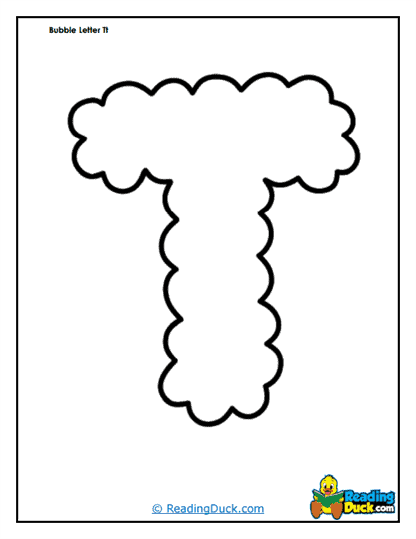Bubble Letter Tt Worksheets
About Our Bubble Letter Tt Worksheets
This compilation of worksheets was created to help young learners recognize, write, and become familiar with the letter Tt in a fun and engaging way. These worksheets typically feature large, stylized bubble letters that children can trace, color, or decorate, making the learning process visually appealing and interactive. They may also include complementary activities such as matching words that start with "Tt," identifying uppercase and lowercase forms, and practicing phonics by connecting the letter to its associated sound. By focusing specifically on one letter, these worksheets create a targeted and structured approach to foundational literacy skills.
The design of Bubble Letter Tt worksheets supports multiple learning styles. Visual learners benefit from seeing the letter in various formats and engaging in creative coloring or design tasks, while kinesthetic learners can trace the letters and physically interact with the shapes. Many of these worksheets also include prompts for verbal or auditory engagement, such as practicing the /t/ sound aloud or identifying objects that begin with "Tt." This multi-sensory approach makes the worksheets suitable for individual practice, small group activities, or even as part of a classroom lesson plan.
Improving Reading Skills
They are highly effective for building reading skills by strengthening foundational literacy concepts. Tracing and writing bubble letters improve fine motor skills, which are essential for letter formation and handwriting fluency. When paired with phonics exercises, these worksheets help children connect the written letter "Tt" with its corresponding sound, an essential step in decoding words during reading. Repeated exposure to the letter through various activities reinforces recognition and recall, which are crucial for fluency.
The worksheets often incorporate vocabulary-building exercises, such as identifying words that start with the letter Tt or grouping objects based on their beginning sounds. This not only expands a child's vocabulary but also develops phonemic awareness, the ability to hear and manipulate sounds in words. By encouraging children to practice saying the /t/ sound and linking it to written words, these worksheets create a bridge between spoken and written language, a key component of early literacy development.
Teachers can also use Bubble Letter Tt worksheets to introduce sight words or simple sentences that include "Tt" words, fostering an understanding of context and meaning. For example, sentences like "Tom took a toy" allow students to see the letter in action within a real-world context, improving comprehension skills. By combining letter recognition with phonics, vocabulary, and comprehension activities, these worksheets provide a comprehensive framework for early reading development.
The Difficulty with the Letter T
The letter "Tt" can be tougher for students to learn due to a combination of visual, auditory, and developmental challenges that affect early literacy. Unlike some other letters, the "Tt" sound (the /t/ phoneme) is a voiceless sound, which means it is produced without using vocal cords. This can make it harder for young learners to distinguish the /t/ sound from other voiceless sounds like /p/ or /k/. For children who are still developing their phonemic awareness-the ability to identify and manipulate sounds in words-discerning these subtle differences may be challenging.
Visually, the uppercase "T" and lowercase "t" are similar in structure but differ enough that students may confuse them with other letters like "I" or "L." Additionally, lowercase "t" is unique because its crossbar is not a natural continuation of its stroke, requiring students to understand it as a distinct design element. For children just beginning to learn letter formation, mastering this detail can take time and effort. Fine motor control is also required to write "Tt" correctly, and some students may struggle with maintaining the straight lines and sharp angles needed for the letter's formation.
Contextual learning of "Tt" can also be tough because the /t/ sound appears in various positions within words-beginning (e.g., "toy"), middle (e.g., "butter"), and end (e.g., "cat"). Learning to recognize and produce the sound consistently in these different contexts can be tricky for young learners. Additionally, English phonetics can add to the confusion, as in some words, the "T" may be silent (e.g., "castle") or sound different depending on dialect or surrounding letters. These factors combine to make "Tt" a letter that requires more focused instruction and repeated practice for mastery.









